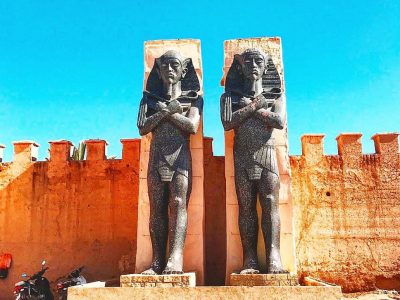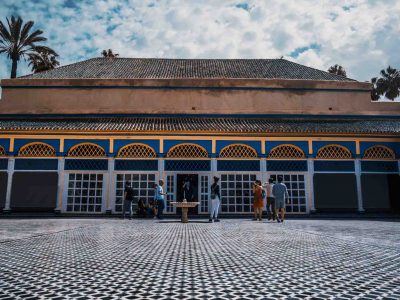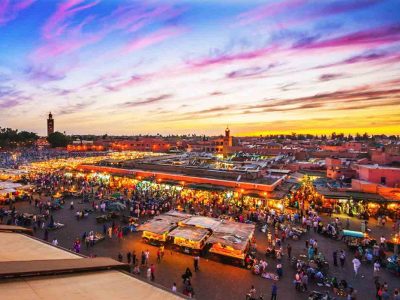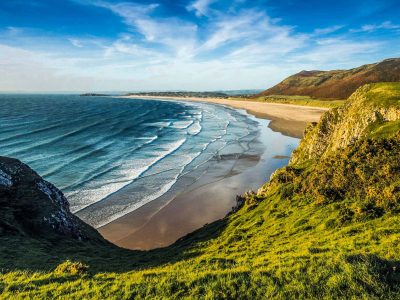Features to start


This Grand Morocco Tour 10-Day features a perfect mix of culture, history, adventure, and relaxation. Explore imperial cities, mountain villages, desert landscapes, and coastal ramparts. Begin in northern Morocco in Tangier and Chefchaouen before working your way south to Fes, through the Desert, over the Atlas Mountains to Marrakech and Essaouira.
Brief Highlights of Grand Morocco Tour 10-Day
Day | Highlights | Overnight |
Day 1 | Arrive, Tangier and Chefchaouen | Chefchaouen |
Day 2 | Roman Ruins of Volubilis and the imperial cities of Meknes and Fes | Fes |
Day 3 | Fes: Exploring the Imperial City and medieval Medina | Fes |
Day 4 | Middle Atlas: Erfoud, Merzouga and the Sahara | Merzouga |
Day 5 | Adventures around Merzouga, Rissani market, and Todra Gorge | Todra Gorge |
Day 6 | Dades Valley, Ouarzazate, and AïtBenhaddou Kasbah | AïtBenhaddou |
Day 7 | Tizin’Tichka Pass over the High Atlas mountains to Marrakech | Marrakech |
Day 8 | Marrakech: Exploring the Red City | Marrakech |
Day 9 | Essaouira | Essaouira |
Day 10 | Return to Marrakech; Depart |
Morocco 10-Day – Grand Tour From Tangier—gateway Europe to Africa! In the south of Spain, explore the medina (old district), a café in the fashionable Zoco Chico area, or a paseo along the seafront. Alternatively continue to Chefchaouen in the Rif Mountains. Enjoy the gorgeous road and trek to the Cascades d’Akchou (Waterfalls of Akchour). Chefchaoen’s small lanes and charming buildings seem infinite. Locate a restaurant or café in Plaza Outa el Hammam and people-watch while eating. Although non-Muslims can’t enter, the Great Mosque is worth seeing. From there, see the neighboring kasbah, garden, museum, and jail cells. Go beyond the city gates to Hotel Atlas and ascend to the rooftop for a panoramic view of the Blue City. For the most active, cross the Ras el Ma Spring and climb the trail to the abandoned white Spanish Mosque. When the sun sets behind the mountains, take one final look at Chefchaouen.



Before leaving for Fes, photograph the empty streets. Visit the UNESCO-protected Roman ruins of Volubilis. Explore merchant homes with working heating systems, temples, and mosaics. Continue to Meknes, a smaller, less crowded Fes, to see a historic imperial city. Imperial City and Medina are the main attractions. Visit the Royal Stables, Bab al-Mansour gate, and Moulay Ismail Mausoleum. Reach Fes. Fes’ massive old medina is worth getting lost in. Visit the Merenid Tombs north of Fes for a panoramic view of the city and surrounding area before entering the medina. Descend the hill and return to your riad (a traditional Moroccan house with an interior garden) for the evening.



The oldest of Morocco’s imperial cities (Meknes, Marrakech, and Rabat) is Fes. The UNESCO-protected city retains its medieval beauty. Fes has two historic medina neighborhoods, Fes el Bali and Fes el Jdid, and the early 20th-century French-designed Ville Nouvelle. Start at Fes el Bali with your guide to explore the medinas’ small, maze-like alleyways (789 ACE). Pass the spice, leather, and pewter souks with Spanish and Tunisian architecture. Visit the Chouara Tannery, famous for its bitter scent, and climb to the roof of an adjacent store for a better view. Visit the 14th-century Al Attarine Madrasa and enjoy the zellij tile work before visiting Al-Qarawiyyin University, one of the oldest institutions in the world (859 ACE). Fes el Jdid’s mellah (ancient Jewish district) offers another panoramic perspective.



South through Middle Atlas cedar forests over the Col du Zad pass. Barbary macaque monkey families will be in the trees and along the road as you drive to Midelt, the “apple city,” for lunch. Enjoy the Moulouya River and apple orchards. Cross the Tizin’Talremt pass into the Ziz Valley’s palm oases. Merchants built ksars to secure their goods.
Erfoud will see Sahara sand dunes. Winds move dunes. A nomadic Berber family may serve tea. Visit Erfoud to see its mines turn fossil-rich rock into decorative and useful items. Erg Chebbi’s massive dunes await. Some 656.2-foot (200-m) dunes cover 13.5 square miles (35 square km) and change color with the sun.
Before sunset, ride a camel to camp outside Merzouga. Watch the sunset from the nearest sand dune. Return to camp for a starlit dinner and Berber music by the campfire. Bedouin tent.



Before sandboarding, watch the desert sunrise. Erg Chebbi and ATV tours are also available. Visit nearby Khemliya, a traditional Saharan village, and enjoy drumming and dancing before walking around. Leave the dunes and enter Rissani’s impressive gate, a market town. Find the “donkey parking lot” to enjoy the livestock auction.
Go to Tinerhir. This desert town offers stunning views of neighboring towns hugging the extensive river oasis (30 miles or 48 km of palm trees). Todra Gorge is today’s final stop. 984 feet (300 m) high and carved by the Todra River through red limestone, you can walk around the gorge and relax in the cool shallow river below.



AïtBenhaddou is Morocco’s most renowned kasbah. Pass through Boumalne-Dades. Visit Kela’aM’gouna’s rose bushes bordering farmland. See how rose petals become rose water and oil at a rose collective. Continue west to Ouarzazate and learn how Lawrence of Arabia, Gladiator, and Black Hawk Down were filmed nearby. Take a film studio tour and visit the Musée du Cinema to learn about filmmaking and the area.
Visit AïtBenhaddou. The 11th-century UNESCO World Heritage site ksar was an important trans-Saharan trade route stop. After checking into your old town hotel, explore the empty streets in the late afternoon. Climb the old Granary to see the kasbah and its surroundings. Game of Thrones fans may want to visit the river to see the gates. Dinner overlooking the valley after the day crowds leave.



Depart AïtBenhaddou to climb the High Atlas highlands. The mountain range’s tallest peak is 13,671-foot Mount Toubkal (4,167 m). Stretch your legs at the peak for a mountain panorama. Visit an Argan Oil Cooperative in Taddert to learn and try olive processing. Climate and terrain vary dramatically as you descend the High Atlas. You’ll soon join Marrakech’s din.
After a long drive, relax at your hotel and enjoy the day. Jemaa el-Fna, the busiest plaza in Africa, comes alive with musicians, entertainers, snake charmers, games, and food booths in the early evening. If you wish to watch from afar, have a mint tea and a meal at one of the numerous cafés around the area.





Marrakech, nicknamed the “Red City” for its 1000-year-old red sandstone city walls and buildings, has thrived since the Berber Empire (1062 ACE). Start your half-day tour at Souk el Attarin (spices), Souk Haddadine (blacksmiths), and Souk Smata (slippers). Visit Souk des Teinturiers (the dyers’ souk) and the Koutoubia Mosque, noting the open areas off certain alleyways. Medieval fondouks housed travelers, merchants, and their animals.
Marrakech’s highest tower is the hard-to-miss Mosque’s 253-foot (77-meter) minaret. Before visiting Ben Youssef Madrasa, relax in the nearby gardens. This 16th-century madrasa housed mosque students. Enjoy Moroccan carved cedar, stucco plaster, and zellij tiling. The Marrakech Museum and Museum of Moroccan Arts have more traditional art and woodwork. The Kasbah area south of Jemaa el-Fna features the Saadian Tombs, El Badi Palace, Bahia Palace, and Jewish Mellah and cemetery.




Leave the Red City and cross wide plains to Morocco’s west coast. Travel through an endemic argan tree forest. Goats may eat argan fruit in tree branches. Visit an argan cooperative to learn how the tree’s oil is extracted and used in food and cosmetics.
After Marrakech, relax in Essaouira, a port city. Walk the coast’s 18th-century Skala de la Kasbah. European engineers designed the walls with old brass canons for Atlantic views. Visit the UNESCO-protected medina before visiting the windswept beach. Jimi Hendrix fans may want to take a taxi to Diabat at Essaouira’s beach, where he spent time. Walk back to Essaouira and eat fresh seafood.




Stroll along the beach or pick up any last-minute curios before heading back to Marrakech.
If time allows, visit the Majorelle Gardens. Not far from the bustle of the medina, wandering the gardens filled with sub-tropical plants, bamboo, lilies, and palms, is a perfect place to escape the afternoon heat and noise before you catch your return flight home. end of the 10-Day Grand Morocco Tour.

Address: 86 Lot Hiba, 30000, Morocco
Phone: +212 613-504732
Email: moroccoclassictours@gmail.com
SITEMAP

